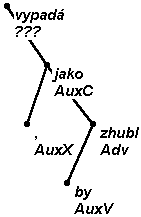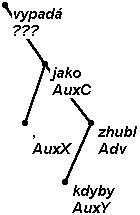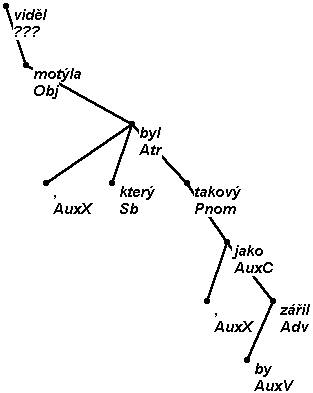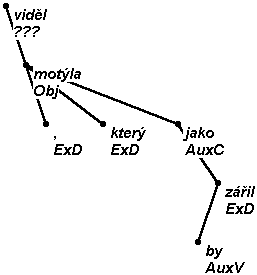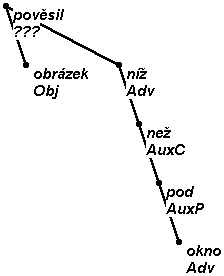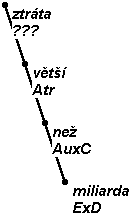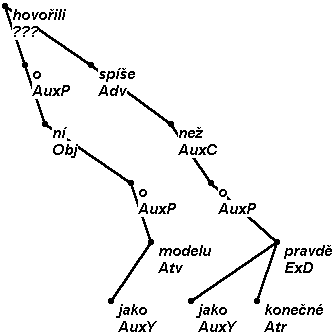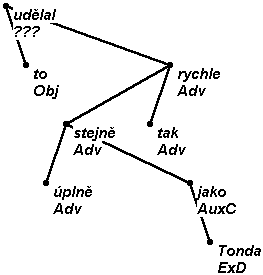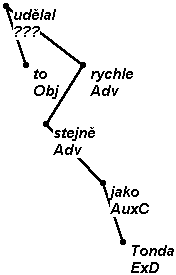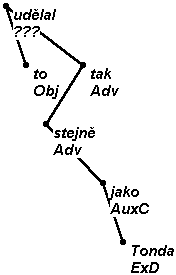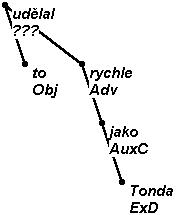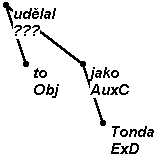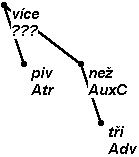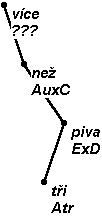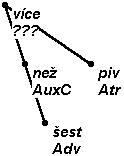The expression jako (as) is ambiguous and it can be used also in other phrases than those of comparison, see esp. sect. The conjunction jako introducing complement or object, the relevant parts of the sections devoted to complements and objects, and the sect. Non-agreeing attribute expressed by a noun introduced by the conjunction jako (as, like) and Attribute expressed by a subordinate clause.
The conjunction než (than) can introduce also a specific case of subject (see Subject introduced by the conjunction než (than, but)).
The conjunction než requires an adverb or an adjective (esp. in the comparative) to be present, with which the comparison is being made; therefore, než is suspended on this adverb or adjective.
In the phrase stejně jako (similarly as) the expression stejně can be deleted; if stejně is present, then jako depends on it; if stejně is missing, then jako is suspended under that node that would be its governor without a violation of any syntactic relation (i.e. the absence of the word stejně is not a good reason to use afun ExD in case where it would not be used otherwise).
The structures with conjunctions jako and než expressing comparison are regarded as adverbials (Adv); however, deletions are frequent, in which case afun ExD is assigned. See also Adverbial expressed by a clause (or a group) with conjunctions jak(o) - as, než(li) - than.
If jako/než is followed by a full embedded clause (containing a tensed verb), the clause depends on the expressions of comparison (stejný/stejně jako similar as, velký jako big as, jinde než elsewhere, jinak než otherwise. The expression stejný/stejně can be deleted and then the clause is suspended on the node where this expression would have been suspended.
The sentence in the last example is a full embedded clause (jako by zářil as would he-shine), but it will get afun ExD because the governor, namely the expression of comparison takový (such) is missing (this expression is present in the previous example).
Warning
If jako/než is followed first by another subordinating conjunction and only then a tensed verb (as in přinesl mi jiné knihy, než když tu byl minule he brought me different books than when he was here last time), the clause is treated as an ellipsis (see Phrases assigned ExD below) and assigned afun ExD.
If a complete embedded clause has not been found, it is necessary to decide whether the element standing in its place may get afun Adv or if an ellipsis is the case (ExD). Adv is assigned if both elements that are compared are on the 'same' level, which can be determined on the basis of the following three criteria:
-
nothing can be inserted into the phrase of comparison (ex. (1) cannot be reformulated as pověsil obrázek níž než to pověsil pod okno he hanged the picture lower than he hang it under the window),
-
the element following the conjunction could be placed in the position where the original phrase was placed (ex. (1) can be transformed as pověsil to pod okno he hanged it under window),
-
the element following the conjunction is semantically “equivalent” to the element before the conjunction; if the element before the conjunction is in comparative, it is necessary to use its basic form: in this sense, the expressions nízko (low) and pod okno (under the window) are “equivalent” in (1).
The phrases of comparison are elliptical: the verb is followed by one or more elements, without a verb, so that they cannot be treated according to the points mentioned above (one of these members may be an embedded clause that would modify the predicate of the immediately subrodinated clause - see the warning in point A complete embedded clause above). For such cases, we use afun ExD (see also part Ellipsis of predicate in clauses introduced by conjuctions jak(o) (like), než(li) (than)).
There will be few cases of the type A syntactically suitable element, cf. the ambiguity with udělal to jindy než včera (he did it at another time than yesterday):
Let us present some more examples with the conjunction jako:
In ex. (1), (2) and (4) the position of the word Tonda (ExD) can be occupied e.g. by the word kvalitně (perfectly) with afun Adv. On the other hand, in ex. (3), (5) and (6) such a word cannot be added.
Let us present some more examples with the conjunction než (than):
The meaning of (1) is clear: a man was drinking beer and the total of glasses of beer he drank was more than three. In (2) the number of glasses is not so important - the sentence only says that he drank three glasses and something in addition (maybe a liquor, a glass of whisky, milk or perhaps some more glasses of beer). The phrase více než šest piv (more than six glasses of beer) is then ambiguous (this holds for numerals denoting higher numbers than four): this is illustrated by the structures in (3) and (4).
Let us add that with more complicated structures of quantity, the part expressing the quantity is suspended on the conjunction než and the part expressing the counted objects is suspended on the expression více (more). The “scope” of these parts is discussed in part Representation of a numerical expression of quantity.



